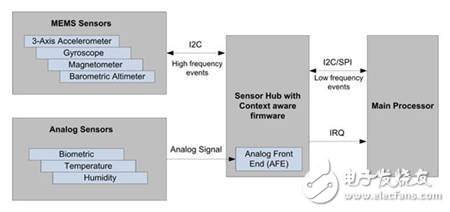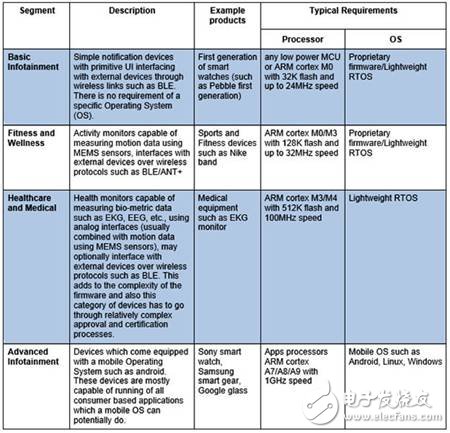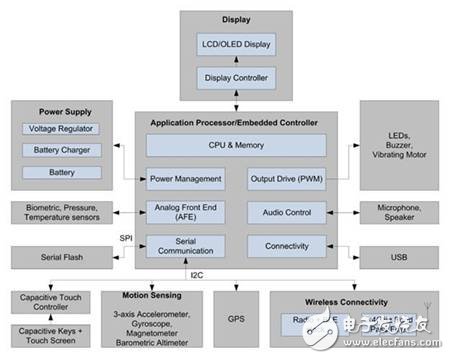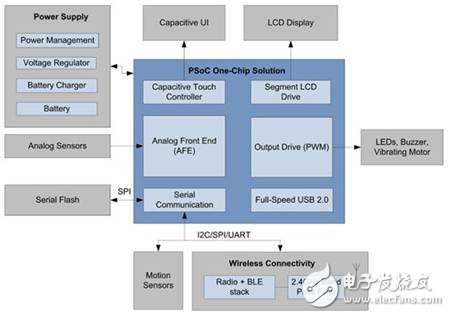"Wearable" devices are microelectronics that are wearable by the human body and are usually integrated with or replaced by existing accessories such as watches. With the support of IoT technology, this market segment is developing rapidly, so the demand for more compact and more intuitive devices is also rapidly increasing. At present, smart watches, smart glasses and sports and fitness activity trackers reflect this trend. In addition to the consumer market, the medical industry has a higher demand for monitoring equipment for physical condition and function.
The most important electronic component in wearable devices is the microcontroller (MCU). Because these MCUs require not only small size but also more functionality, integration is another big factor. In this article, we will explore the different needs of wearable electronic systems, how to segment the market according to relevant needs, how different components and MCUs in typical wearable devices can meet the relevant needs.
Wearable device requirements
Aesthetics: Wearables need to be stylish and beautiful, and need to be able to match current fashion accessories such as accessories, watches, glasses and more. Aesthetics are so important that semiconductor giants such as Intel are working together with the fashion industry to create stylish devices.
Capacitive touch sensing technology is a key technology to enhance aesthetics. Capacitive user interfaces need to support a variety of shapes (including curved surfaces), be able to prevent liquids, and support thick overlay sensing. Cypress's CapSense and TrueTouch technologies make this type of demand practical.
Size: As mentioned earlier, this device must be small enough for easy integration into wearable devices. At the same time, however, the device should integrate more features in the same space. Technologies such as system-on-a-chip (SoC) and chip-scale packaging (CSP) help reduce size. For example, Cypress offers Programmable System-on-Chip (PSoC) devices with a variety of package options such as WLCSP.
Waterproof: Wearables are taken anywhere by the user. Therefore, the key is that these devices are designed to withstand environmental conditions such as water droplets, moisture, sweat, and the like.
Power consumption: Since wearable devices are battery powered, there are special challenges to reducing their power consumption. Since the wearable device is mostly a monitoring device, unlike other mobile devices, it needs to be always on and remain connected. For example, a smart watch needs to always display time and connect to the phone wirelessly via Bluetooth or the like in order to receive reminders; the pedometer needs to calculate the number of steps and report to the mobile phone application; likewise, the heart rate monitor needs to provide monitoring and reporting at all times. However, because the device needs to reduce the overall size, it will limit the battery capacity from the inside.
These devices need to operate at ultra low power to extend battery life. This requirement places special demands on the MCU and firmware algorithms. The 32-bit ARM architecture is a common CPU technology for wearables because it provides the best performance and energy efficiency. In addition, wireless technology such as ANT+ and Bluetooth low energy (BLE) can be designed to achieve low power consumption.
Wireless communication: Wireless connectivity is very important for wearable devices because the latter needs to interact with one or more devices. Depending on the type and functionality provided, such devices need to support different wireless protocols such as Wi-Fi, ANT+, BLE, proprietary protocols based on IEEE 802.15.4, and so on. Some devices need to support multiple protocols. For example, a watch uses a proprietary wireless protocol to communicate with the heart rate monitoring chest strap, while using BLE to communicate with the running application in the phone.
Choose the appropriate application processor or microcontroller
In addition to advanced infotainment devices that require application processors, MCUs can meet the needs of most wearable devices. In addition, the latest MCUs integrate most of the functionality in a single chip. This plays an important role in reducing the overall size of the wearable device and the cost of the BOM.
For example, the ARM cortex-M controller can drive a simple wristband, but smartwatches require an application processor to run complex operating systems such as Android.
As mentioned earlier, 32-bit ARM processors are very popular in wearable devices because they provide the best performance and energy efficiency. Modern controllers such as PSoC use the advantages of the ARM architecture to integrate advanced analog and programmable digital functions in a single chip, while also using the ARM cortex-M core.
Some advanced devices use separate coprocessors to transfer sensor data processing from the host processor. This is required because the device may have sensor data loads that require real-time analysis and CPU support. This feature is called a “sensor hub†or “sensor fusionâ€. Figure 1 illustrates the role of a sensor hub in a wearable system.

Figure 1: The role of a sensor hub in a wearable system.
Operating System: Depending on the type and functionality provided, the wearable device may or may not require a specific operating system. For example, a simple watch that monitors temperature, measures motion with a 3-axis accelerometer, and displays time with a monochrome segment LCD can run a lightweight RTOS, while a smart watch used to extend the phone's functionality needs to run an advanced operating system such as Android. . At the same time, sensor hubs require special firmware with context-aware algorithms.
Market segmentation
Proper market segmentation enables designers to develop the right products while helping users choose the best equipment. Table 1 lists the different market segments based on device capabilities. The table increases from top to bottom by the complexity of the market segment.
Table 1: Market Segmentation of Wearables

Components in wearable electronics
Figure 2 shows a block diagram of the wearable system that contains all of the features we have described previously.

Figure 2: Wearable electronic system
Depending on the type of host processor used, more peripheral functions can be integrated into a single processor chip. For example, most PSoC devices can easily integrate capacitive sensing and eliminate the need for a separate touch controller. Similarly, the PSoC4 based on the Cypress Cortex M0 integrates an LCD driver. Figure 3 shows a block diagram of a smart watch, which is a typical example of the first generation of wearable devices.

Figure 3: Typical smart watch system
An important subsystem of a wearable device is the data acquisition or sensor subsystem. Depending on the type of device, it may be a simple system with only a few MEMS sensors, or a complex system with a dedicated sensor hub to connect the relevant sensors. MEMS sensors play a key role in fitness and health equipment for monitoring the movement of the human body. These sensors are also known as motion sensors. All of these sensors provide digital motion information via an I2C or SPI communication interface. Examples of such sensors include 3-axis accelerometers, gyroscopes, magnetometers, and barometric altimeters.
Analog sensors are widely used in healthcare devices. Examples of such sensors include biometric sensors such as heart rate monitors, EEGs, and the like. Analog sensors require a special component called the analog front end (AFE). The AFE contains an op amp, filter, and ADC that are used to condition and convert the analog signal to a digital signal for CPU processing. This feature can sometimes be integrated with the CPU (for example, the design of the PSoc allows its communication function to be used directly as a sensor hub).
Another important subsystem is the user interface (UI) system. How users interact with wearable devices is an extremely important consideration. To minimize complexity, interactions should be as intuitive as possible. Capacitive touch sensing is currently the most intuitive UI. Depending on the application, capacitive UIs can be implemented in a variety of ways, such as touch screens, buttons and sliders.
UI components such as LEDs, buzzers, and vibration motors can help provide reminders and feedback to the user. For example, the smart watch design shown in Figure 3 is connected to the phone and needs to alert the user when there is a message.
Pulse width modulation (PWM) is the key to driving these components. PWM can be used to achieve various LED effects such as dimming, and it can also provide various vibration effects that realize tactile feedback. These techniques require precise timing and frequent CPU processing if implemented in firmware. Therefore, the key is to choose a processor/controller that supports hardware PWM.
YLTelecom produces a variety of Network Faceplate, these faceplates are compatible with our keystone jacks. We have 86 type Faceplate , 120 type faceplate, USA Type faceplate,UKtype faceplate, Australian Type Faceplate, French Type Faceplate, and also German Type Faceplate. These faceplate are available with 1 port, 2 port, 3 port, 4 port, 5 port, and 6 port. They are complaint with international standards and with good material. Due to high quality, our faceplate has recognized by international customers for many years.
We are Quality UTP / FTP Network Keystone Jack Plastic Faceplates with Shutter RJ45 Module manufacturers & exporter,we pffer you many type of Faceplate,like Rj45 Faceplate,Telephone Faceplates,86type Face plate.We can promise you the good quality and low price.

Faceplate
Network Faceplate, USB Faceplate, Rj45 Faceplate, Telephone Faceplates
NINGBO YULIANG TELECOM MUNICATIONS EQUIPMENT CO.,LTD. , https://www.yltelecom.com